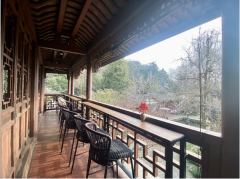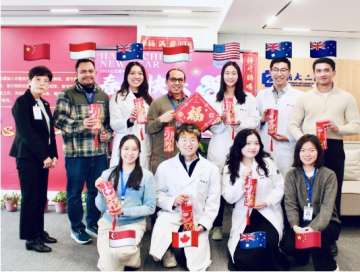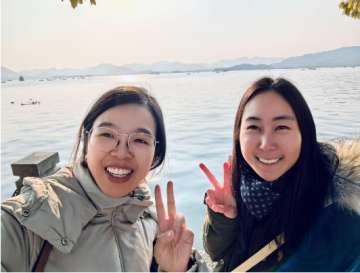Reflections from Hangzhou
Reflections from Hangzhou
By Jenny (Jia) Tang, MD, MBA, and Allison Woods, MD
In January and March 2025, two CA-3 resident physicians of the UCLA Department of Anesthesiology & Perioperative Medicine, Jenny (Jia) Tang, MD, MBA, and Allison Woods, MD, became the 13th and 14th participants of the International Rotation at the Second Affiliated Hospital of Zhejiang University (SAHZU) in Hangzhou, China. During their four-week clinical rotation, Drs. Tang and Woods engaged in supervised perioperative care and learned about Chinese anesthetic practice and culture. Here, they reflect on their experiences at SAHZU and share observations and lessons learned.
How would you describe your overall experience on the trip?
Dr. Woods:
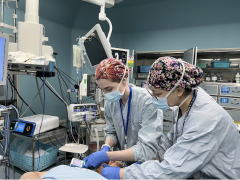
This rotation marks my first (and hopefully not last) time visiting China, and I could not have asked for a better experience. In true SAHZU fashion, everything about the rotation was organized with incredible efficiency. On my first day in the hospital, I had an orientation with the department leadership, during which I was presented with a calendar for the upcoming month that detailed the service I would be rotating on and the educational requirements that would be fulfilled for each day. It was very clear that the department put a lot of thought and effort into making sure that I had an educational experience. Initially, I was worried about the language barrier because (surprise!) I don’t speak any Mandarin, but I did not feel that this got in the way of my learning at all.

Over the course of 30 days, I rotated with almost every subspecialty in the department and visited three of SAHZU’s four campuses in Hangzhou. I was able to tour their new simulation center and watch residents during their simulation sessions. I attended departmental didactics each morning, using my translator app to keep up. Every day was a new and different learning experience!
The department leadership also went out of their way to make me feel welcome, both at the hospital and in Hangzhou. I was lucky to meet some wonderful attendings and residents who took me under their wing and made my month in Hangzhou unforgettable.
Dr. Tang:
My experience at SAHZU was deeply illuminating on both personal and professional levels. Growing up, I spent nearly every summer in China, often accompanying my grandparents to clinical appointments and even becoming a patient myself a few times. Even then, I was fascinated by how Chinese hospitals were similar to yet strikingly different from those in the US. I would be overwhelmed, for instance, by the sheer volume of people in a lobby in the early morning, all trying to book appointments with the most senior physicians from each specialty. Somehow, that chaotic crowd would miraculously organize itself into seated rows outside each doctor’s office, and patients would be seen and processed like clockwork with remarkable efficiency.
After becoming a physician myself, my curiosity about how medicine is practiced in China continued to grow. The month-long rotation at SAHZU offered an intriguing glimpse into how anesthesiology is conducted at a tertiary medical center in Hangzhou, a city only two hours away from my grandparents’ home. Not only was I able to rotate through various services including cardiac, thoracic, obstetric, regional, and neurosurgical anesthesia, but I also participated in cultural and academic-exchange activities, including a visit to the Quanzhou Orthopedic-Traumatological Hospital in the southeastern province of Fujian. Overall, the rotation opened my eyes to the unique advantages and challenges associated with anesthetic practice in China, and I hope to apply that knowledge in my own practice to become a more efficient anesthesiologist.
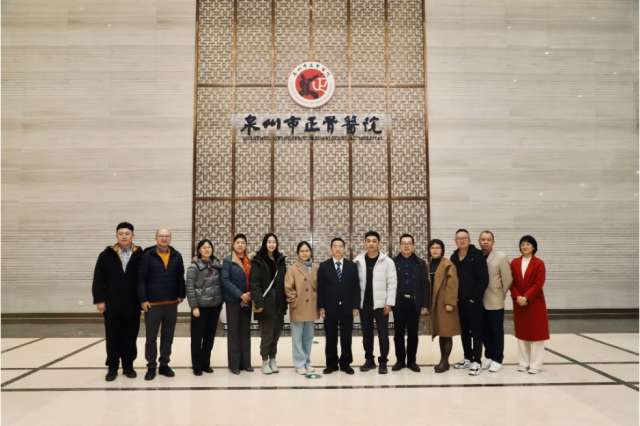
Visit to the Quanzhou Orthopedic-Traumatological Hospital in Fujian, which was originally founded by Shaolin monks. I participated in cultural exchange and learned about how traditional Chinese medicine is seamlessly incorporated into patient care. Dr. Yan provided advice on optimal operations of the hospital’s newly built operating room (below) – notice the wide hallways and automated doors.

What was your daily schedule like? What surprised you the most? Was there anything that was drastically different from UCLA?
Dr. Tang:
Each day started with mandatory morning didactics, which typically were resident-led and consisted of a case report or lecture. Afterwards, I would be assigned to a team for the day. In the OR, I was mainly shadowing and assisting the resident physician, but on other services, such as Acute Pain or the “induction room,” I participated more actively.

A theme that quickly emerged was the emphasis on efficiency. Given the immense volume of cases that had to be completed each day with limited relief staff, every member of the healthcare team was incentivized to maximize productivity, get work done, and go home at a reasonable hour.
Individual output can only go so far, however. SAHZU also employed innovative workflow practices that further optimized productive OR time. The most strikingly different of those practices was the routine extubation of patients in PACU rather than in the OR; this was done by trained nurses under the supervision of the PACU anesthesia attending. Every patient would be connected to a ventilator in recovery and would have a propofol syringe that would be intermittently bolused until the patient was ready for extubation. By removing emergence and extubation from OR time, SAHZU was able to achieve swift case turnovers of 5-10 minutes.
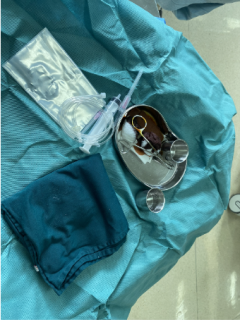
Another noteworthy practice was that of the Preanesthesia Preparation Room, aka “induction room,” where patients would go preoperatively to receive lines and nerve blocks. The nerve blocks would be performed by the Acute Pain Service, and all invasive lines would be placed by the dedicated induction-room team, rather than the patient’s OR anesthesia team. This model not only enabled faster time-to-incision but also excellent resident procedural training. During my one day there, I performed 15 arterial lines and 5 central lines!
Perhaps the most impressive element of all is how SAHZU manages to deliver quality patient care so efficiently yet maintains cost-effectiveness. Indeed, despite high case volumes, waste and expenses are reduced with reusable/sterilizable equipment (including masks, monitors, cloth drapes, and components of arterial/central line kits) and cheaper-but-still-gets-the-job-done’ alternatives (e.g “lunch lady” gloves). That being said, the actual anesthetic management and advanced medical equipment there did not differ
drastically from that at UCLA.

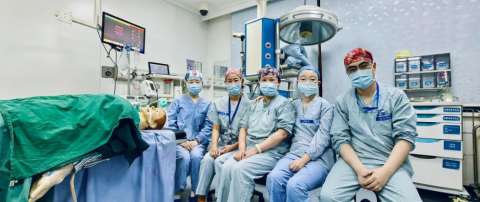
What is residency training like at SAHZU?
Dr. Woods:
To keep up with the sheer number of surgeries performed at SAHZU, the residents (and attendings) work incredibly hard.
On my first day in the hospital, I was asked to give several lectures to the Anesthesia Department, one of which was on efficiency and time management. From my perspective, I was the one with much to learn about efficiency, but they specified that they wanted my input on how their residents could better manage their time outside of the operating room. The anesthesia residents at SAHZU are not only under pressure to perform well on institutional and national exams, they are also required to conduct, publish, and present research throughout residency (much more demanding than our one scholarly project we are required to complete during our 4 years of residency at UCLA). All of these requirements are on top of the 70- to 80-hour weeks that residents regularly work at SAHZU. I was not surprised to hear that many of them are burned out.
The advantage of the amount the anesthesia residents work, however, is the skill they acquire early on in their residency. In the induction room, where patients go to get arterial lines and central lines placed before they head off to the operating room, I watched many junior anesthesia residents comfortably navigate the ultrasound and place lines with the ease that I would expect from a senior resident. Similarly, the Acute Pain Service (APS) runs with extreme efficiency. All patients who are to get peripheral nerve blocks are identified and wheeled into the APS room either pre- or post-operatively and receive their nerve block within a matter of minutes. The blocks are often performed confidently by a resident physician without an attending present (unless they encounter difficulty, which I only saw a handful of times).
What are some practices that UCLA and SAHZU can learn from each other?
Residency education
While SAHZU certainly runs very efficiently, they are searching for ways to improve the anesthesiology residency program. Leadership was interested in how UCLA structures resident learning and intraoperative teaching. I told them about Grand Rounds, weekly protected learning time for residents, Dr. Jason Lee’s iconic PowerPoint presentations that he brings into the OR to aid in teaching, and Dr. Maziar Nourian’s new weekly teaching emails. I offered the possibility of creating dedicated learning tracks like the ones that are available to residents at UCLA, such as the Global Health Track, Leadership Track, and Research Track (which I think would be of particular use to them, as they place a large emphasis on churning out quality research). I also suggested creating evaluation forms for both residents and attendings so that everyone can get more timely feedback on their performance. I am now told that they hope to have the evaluation program rolling out by this summer.
Uniform
Since SAHZU has numerous visiting anesthesia residents at any given time, role and rank designation was crucial, especially in high stress situations such as codes. To address this issue, SAHZU assigned specific caps not only for physicians of each role (surgeon, nurse, anesthesia), but also for ranks within each role (junior, senior, attending, charge nurse). I, therefore, had a cap of a specific color and pattern that I wore daily. This system decreased the time needed for clarifying roles and enabled more time focused on patient care.
Anesthesia support and equipment
Fast turnovers mean less time for OR anesthesia staff to prepare for the next case. At UCLA, anesthesia technicians are crucial for obtaining essential equipment, especially in large cases such as cardiothoracic surgeries. At SAHZU, however, that responsibility is shouldered by the anesthesia teams themselves, leading to demanding mornings and turnovers. This is further exacerbated by the lack of medication-dispensing machines such as the Pyxis, thereby requiring staff to visit pharmacy for all medication needs. Although anesthesia techs and Pyxis machines require monetary investment, they may allow for increased efficiency and patient safety.
NMB Monitoring
Interestingly, neuromuscular blockade monitoring was not utilized, nor were reversal agents routinely administered. Though I was initially shocked by this and concerned about residual neuromuscular blockade and patient awareness, I was told that such complications are rare and personally did not witness any during my month there. Nevertheless, I gave a lecture on the consequences of residual neuromuscular blockade, several of which may not be readily apparent post-extubation and would recommend that SAHZU adopt reversal of blockade as routine safe practice.
What did you do outside of work?
Dr. Woods:
Outside of the hospital, there was so much to see and do around the city of Hangzhou. After leaving the hospital, I spent many evenings walking around West (Xi) Lake, hiking the Longjing Tea plantations, marveling at the endless amounts of pagodas, exploring old alleyways, and eating some pretty incredible food. I spent a lot of time after work with several of the anesthesia residents doing “normal” life activities such as going to the mall (Hangzhou was full of them), grabbing dinner or boba, and getting our nails done. The members of the anesthesia department were very gracious hosts, always making sure I was comfortable (and fed) and helping me plan my weekends exploring other parts of China.


Dr. Tang:
Hangzhou is an amazing city with so much to offer, and I was able to do a new activity every day. My fondest memories include enjoying afternoon tea while admiring the sunset on West Lake, exploring lantern-lit, winding alleyways in the evenings, and putting in some serious karaoke time… all while eating absolutely delicious food and practicing my Chinese. I also celebrated Chinese New Year with my family for the first time in 30 years!
